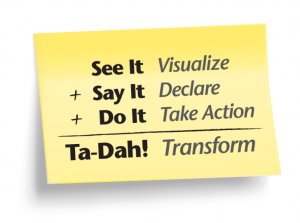Do It! – Take Action
Words can make a difference. And when words imply action, this can make a dramatic difference in the results.
Does your child have great ideas, dreams, and visualizations, but sits on the sidelines, waiting for everything to be just right, or fearful that he may fail at the task. “It’s not the right time,” or “Maybe later,” he states as his excuse. Have you ever heard those types of comments? Have you ever responded, “Just try it,” or “Just do it.”
Everyone has fears, some so significant that they stop you in your tracks; and some so minor that you laugh at them when you think back; and some more of a challenge.What are your fears? Heights? Failure or making a mistake? Looking stupid? Not being good enough? Not having friends? Not being loved?
Are you able to manage your fears, or do your fears manage you? Children also have fears. Fear can stop your child from taking action. He may be afraid to go out for a sport because he’s not very coordinated. Or he may avoid raising his hand in class because he may ask what he thinks is a stupid question and be laughed at.
The drive to be perfect can often interfere with your child’s freedom and openness to learning. This tendency often shows up with bright, gifted children.
Action Plans, Do They Work?
Watch how your child functions. Does he have difficulty completing tasks because of poor organizational skills? Does his desk looks like a disaster? Does he forget where he puts his homework? Is his room a mess? What now?
Successful businesses utilize action plans for their projects. I suspect you’ve created a form of an action plan in the past week. Do you make a “To Do” list— items that you need to pick up at the store, etc.? Certainly not a detailed action plan, yet one that notes something that needs to be completed. An Action.
Action plans are great organizational tools to follow through on small or enormous projects. Without a plan, accountability and empowerment, an organization has no foundation.
How about modifying this successful action plan strategy to use with your child? When your child builds the skills to plan and organize his activities, his time for work completion and productivity increases. As he becomes more effective and efficient, avoidance behavior and emotional outbursts often are reduced.
Some kids are well organized in all areas of their lives, some are disorganized, and many are at different levels of organizational skills. The goal is to find an organizational system that allows your child to Do It!; take action. It’s a great habit to start, as it can build a lifetime of organizational skills.
The organizational chart may be easily designed as a checklist, or could be more elaborately designed with stickers, pictures or whatever he loves to do artistically. The specific activities on the chart are what you and your child have agreed upon. If you independently make the chart for your child, don’t be surprised if your child doesn’t follow the chart very well. Your child needs to own the chart from the very beginning. It starts with his visualization, declaration and then the steps and methods to record accomplishments.
The more fun and creative this process becomes, the more likely your child will use and continue to stay with the plan. If your child becomes bored or stops working on his plan, then a modification to the process is needed.
Click here to see a sample organization charts (action plan) for your child.
- It’s Never too Late to Expand Your Vision - February 1, 2023
- It’s Never Too Late To Expand Your Vision Interview - January 27, 2023
- Dr. Hellerstein’s Featured COVD Interview - September 25, 2022




No comments yet.